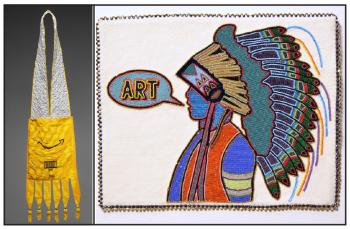Image Caption
Local Journalism Initiative Reporter
Windspeaker.com
The National Gallery of Canada in Ottawa opened its doors May 17 for the Radical Stitch exhibit. It features 101 beadworks by 44 First Nations, Inuit and Métis artists.
The exhibit, which runs until Sept. 30, focuses on beadwork that connects viewers with the past by showcasing artwork of the present, from wearable art to portraiture and more. It’s one of the largest shows of contemporary beadwork with artists from Canada and the United States.
Radical Stitch “includes some of the best of the best beadwork artists in Turtle Island,” said co-curator Michelle LaVallee, director of Indigenous Ways and Curatorial Initiatives at the National Gallery of Canada.
“It was really important for us to raise the profile of beadwork to show it as contemporary, as part of this age,” LaVallee said. It’s the continuance of something that’s part of Indigenous history.
“You know, art making is part of what our communities have been doing since (the beginning of) time but (we’re) really wanting people to see the skill and labour that goes into making these works, in addition to the aesthetic beauty of beadwork, and hopefully do our part to elicit some awe and respect for the practice.”
The concept of the exhibit became reality five years ago at the Mackenzie Art Gallery in Saskatchewan. The National Gallery of Canada is the exhibit’s fourth stop.
“It really stems from a spark of inspiration I had to, and desire to, uplift beading practices over a couple decades ago when I first started my position at the Mackenzie Art Gallery,” said LaVallee. “But it was really conceptualized… around 2016.”
LaVallee co-curated Radical Stitch with Sherry Farrell Racette, a professor in the department of visual arts at the University of Regina, and Cathy Mattes, associate professor in history of art at the University of Winnipeg.
The exhibit travelled to the Art Gallery of Hamilton and the Thunder Bay Art Gallery prior to the National Gallery.
Originally the number of exhibitors was quite extensive, explained LaVallee, but the list was reduced for touring purposes for the previous two showings. Due to the venue size at the National Gallery of Canada, the curators were able to bring back a number of artists for the current exhibit.
“We are really excited about the attention that the show has been bringing to artists and helping to celebrate their work and to celebrate their efforts,” LaVallee said. “And to bring beadwork into the contemporary sphere in a way that it’s never been exhibited before.”
A key element of the exhibit was to bring the art of beadwork from the stereotype of being a craft into a contemporary space.
“You have next generations of artists, like Nico Williams, who’ve really been creating new meaning and redefining representation and cultural determinism and experimenting with media, whether it be to play with pop culture or imagine new worlds to look at our complex identities,” said LaVallee.
Williams, a Montreal-based artist from the Aamjiwnaang First Nation, creates geometrical and sculptural creations of everyday objects that link to his own history and personal stories. One of the items in the show by Williams is titled Amazon Bag.
“My art is looking at different ways to approach these, trying to replicate sound objects and also responding to works created by our ancestors and bridging the two,” said Williams.
“For instance, the Amazon Bag in the Radical Stitch show, it was looking at bandolier bags.”
Historically, bandolier bags were modelled after European military ammunition bags. They were made using trade cloth, and hundreds of small glass trade beads would be sewn to the exterior of the bag. The bags were then worn as part of men’s ceremonial clothing.
“But we’d also use them as commerce, and we would sell it for, like, we traded it actually for ponies,” Williams said. When he started the Amazon Bag project he read many stories about the historical beaded bags, including one from the depression era when someone had to sell their beaded bag for $5.
“So then, you really think about what value is and… what it represents,” Williams said.
He incorporated an Ojibway pattern monochromatically on the back of his Amazon Bag art piece to address the history of trade.
“I’m looking at Ojibway patterns and I’m always trying to figure out ways to highlight them and to put them into people’s faces, because for so long it hasn’t. It’s been tucked away in drawers,” he said.
“I was responding to works that are in drawers and they’re still in those drawers, because up until the ‘50s it was illegal to practice who we are.”
Another element of the Amazon Bag by Williams is replicated bubble wrap, typically found on the inside of a shipping package.
“I’m always trying to replicate these colonial objects that sort of shower around our territories,” Williams said, adding he really wanted to draw viewers to how historically bags were adorned with flowers or other items that represented who Indigenous people were, but now bubble wrap and other substances are entering the communities from outside sources.
Being part of the exhibit is an honour for Williams, he said, because it’s important for Indigenous creators to bring beadwork back to the communities.
“It is an honour, because there has been so much work that has gone into getting beadwork where it is being appreciated today, and the show is really highlighting so many amazing artists from different communities all across Turtle Island,” he said.
“I love all the curators. They have done such incredible work for so many people and the beadwork exhibition is going to make an impression in people’s minds and it’s going to change things.”
For more information on the show or to purchase tickets visit the National Gallery of Canada website Radical Stitch | National Gallery of Canada
Local Journalism Initiative Reporters are supported by a financial contribution made by the Government of Canada.

